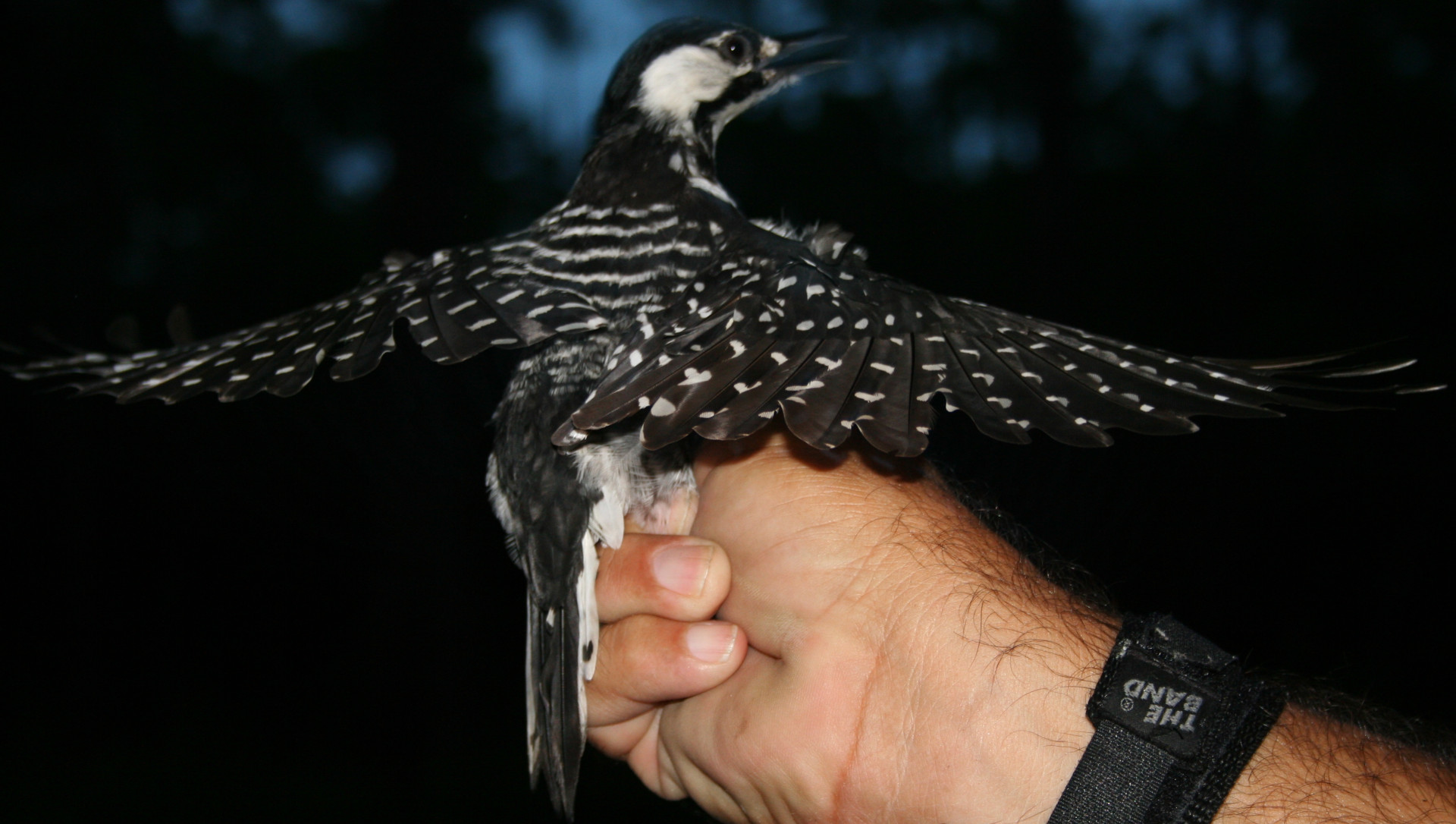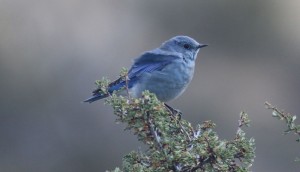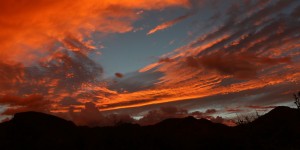The Debi Shearwater Journey pelagic bird trip was perfect; sunny with calm seas. We left from Fisherman’s Wharf in Monterey working the wharf area seeing Sea Otters, Sea Lions and Harbor Seals. There were hundreds of Common Murre, daddy’s & juveniles, Gulls, Gulls, Gulls, with Western Gull juveniles still begging for food, Elegant Terns, and Black Turnstones. But the real adventure was further out.  We watched a Heerman’s Gull surf on a Mola (Sunfish), added 9 new birds and learned quite a bit since the Shearwater boat guides did such a good job spotting and educating. We were able to see both the Laysan and Black-footed Albatross as they soared dramatically up the boat wake, lured in by excited gulls following the chum trail. We were able to see Black Vented, Pink-footed and Sooty Shearwaters, and even caught sight of a Buller’s. In addition, we were able to see Least, Fork-tailed and Ashy Storm-Petrels, even catching a quick view of a Cassin’s Auklet.
We watched a Heerman’s Gull surf on a Mola (Sunfish), added 9 new birds and learned quite a bit since the Shearwater boat guides did such a good job spotting and educating. We were able to see both the Laysan and Black-footed Albatross as they soared dramatically up the boat wake, lured in by excited gulls following the chum trail. We were able to see Black Vented, Pink-footed and Sooty Shearwaters, and even caught sight of a Buller’s. In addition, we were able to see Least, Fork-tailed and Ashy Storm-Petrels, even catching a quick view of a Cassin’s Auklet. 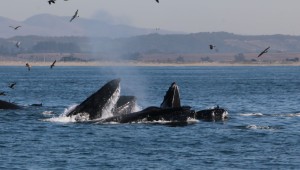 A great deal of birding time was spent watching Whales tail and fin slap, yawn after the first few, but it was very cool to watch Humpbacks as they baled, filter feeding fish and crustaceans into their mouths. We were quite happy with how well everything turned out.
A great deal of birding time was spent watching Whales tail and fin slap, yawn after the first few, but it was very cool to watch Humpbacks as they baled, filter feeding fish and crustaceans into their mouths. We were quite happy with how well everything turned out.
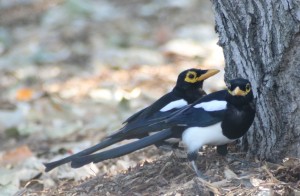 From Monterey, we made a couple stops in 100 degree temperatures to catch a Yellow-billed Magpie (I was so glad that we did since they are quite unique looking) before heading up to Yosemite National Park to cool off. It was here that we thought about the fact that we have been chasing more than birds, we have also been chasing smoke and fires. California, Alaska, Saskatchewan; much of the west has been enveloped in smoke this year.
From Monterey, we made a couple stops in 100 degree temperatures to catch a Yellow-billed Magpie (I was so glad that we did since they are quite unique looking) before heading up to Yosemite National Park to cool off. It was here that we thought about the fact that we have been chasing more than birds, we have also been chasing smoke and fires. California, Alaska, Saskatchewan; much of the west has been enveloped in smoke this year.  In Yosemite, though the fires impeded pretty views, the falls had quit flowing for the year, and we did not add any new birds, we did see this cute Marmot basking in the sun.
In Yosemite, though the fires impeded pretty views, the falls had quit flowing for the year, and we did not add any new birds, we did see this cute Marmot basking in the sun.
California’s Mono Lake is a very unique basin lake which is actually “saltier” than the sea, has no fish, but does have an abundance of brine shrimp which attracts migrating birds. 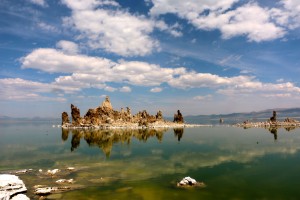 Over hundreds of thousands of years, precipitation of the lake’s salts and minerals caused these beautiful tufa sculptures to form. We didn’t add any new water birds here (although it is always fun to watch Phalaropes swim is quick little circles),
Over hundreds of thousands of years, precipitation of the lake’s salts and minerals caused these beautiful tufa sculptures to form. We didn’t add any new water birds here (although it is always fun to watch Phalaropes swim is quick little circles), 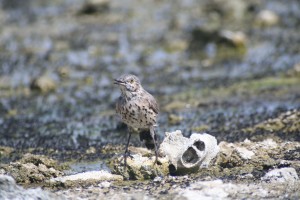 we did add the Sagebrush Sparrow and Sage Thrasher who were taking advantage of the super dry sage habitat surrounding the lake.
we did add the Sagebrush Sparrow and Sage Thrasher who were taking advantage of the super dry sage habitat surrounding the lake.
Next stop… UP! We went looking for species that prefer a much more elevated habitat. In the Lee Vining area, we found the Mountain Bluebird and the Pinyon Jay. Then we took a ski lift ride up Mammoth Mountain to catch site of Gray-crowned Rosy-Finches. I was pretty sure that we wouldn’t really find them, but at least we could at least enjoy lunch at 11,000 feet without having to hike that high. As a pleasant surprise, just when the lift was nearing the top, we actually saw a pair on the ground below. More were seen as they flew back and forth over our heads while hiking the trail at the top!
Between California and Arizona, we stopped at a desert spot where both the Crissal and Le Conte’s Thrasher were reported. We have not done well with Thrashers this year, and are embarrassed to say that we did not even see a California Thrasher in spite of the fact that it was reported as being seen almost everywhere we birded. Sad. But here at the Desert NWR in a scrubby mesquite area near the creek, we heard the tell-tale scratching in the underbrush, and were finally able to spot and identify the Crissal Thrasher; what a curved bill! This National Wildlife Refuge near Las Vegas is a beautiful facility where the water features draw a variety of species, and is well worth a stop if you want to see a refuge that is something other than the typical Dikes and Ducks.
Our last stop before tag team driving 33 hours home, was a repeat visit to Hunter Canyon in Arizona, where we were hoping for views of the Rufus-capped Warbler (we had previously only identified by song) and the rare Slate-throated Redstart. This is the same spot that we took our fist hike after my ankle break, and although we had been hiking for almost a month since then, the climb didn’t seem any easier. As flat landers who spend most of our lives at sea level, these elevations really kick our tails. Yet up we went, only to scratch on both birds after 6 hours of watching, wishing, and waiting. Alas, we had to leave for home without hitting the next goal of 600 birds, but we didn’t leave this site with nothing! We left with additional knowledge which was shared with us by two very knowledgeable birders, Wendy & Mike Schackwitz, who are also doing a husband & wife big year. They are very experienced birders who generously shared tricks and information about the eBird site data, including tools to better plan a big year (since we now consider this our practice big year) and also showed us how they knew our names after chatting just a few minutes but before we even introduced ourselves! It seems that eBird has a top 100 eBirders list for the American Birding Association (ABA) area and we were on it!! Mike and Wendy list the same birds they jointly see separately, and are currently #1 and #2 in the country with 657 species, while we are currently number #6 with 599 species. We are proud to be in the top 10 considering this is my first year birding more than a token number of times, and the first time either of us have birded the ABA area outside of Florida.
Three months to go… do we continue to add birds or relax at home? We shall see if we have it in us to take another trip west after this next 12 day trip south to the Keys, back up to New Smyrna for their Marine Science Center Pelagic Birding Trip, and then over to the west coast of Florida to add (hopefully) even more new birds to our list.
